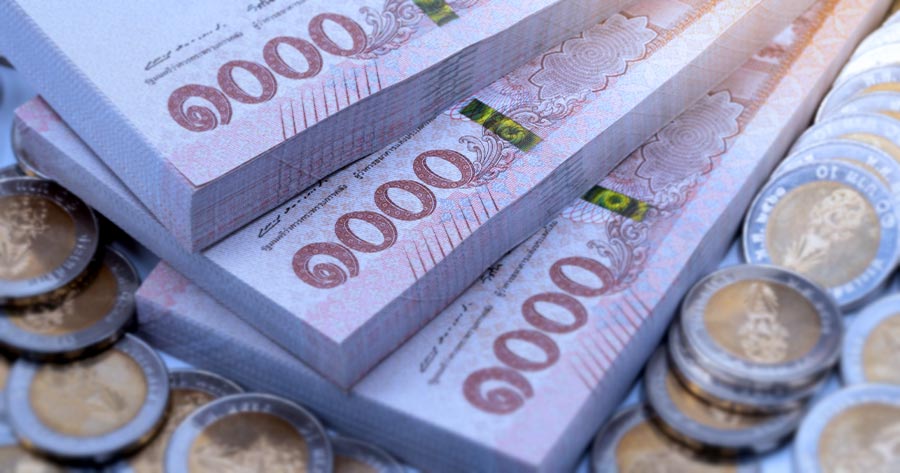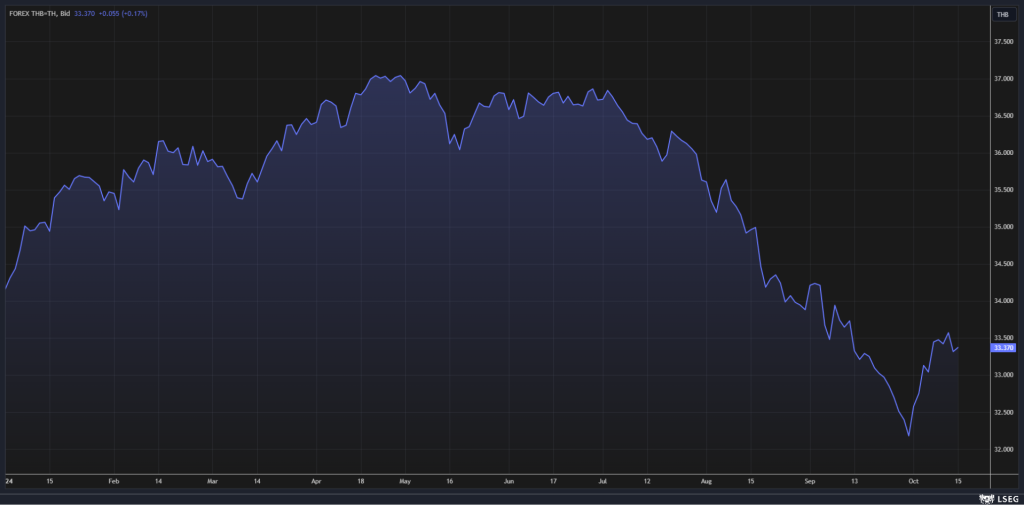The Thai Baht (THB) has experienced significant fluctuations against the U.S. Dollar (USD) throughout the year, with notable movements observed as recently as September and October 2024.
The Baht is now hovering around THB33.25 to USD1.00 after hitting THB32.18 in late September, marking the lowest level in more than two years.
Early in the year, the baht displayed robustness, trading strongly against the dollar. However, this strength waned as the year progressed when the US Federal Reserve maintained its policy rates at 5.5%.
In September, the Baht saw a pronounced strengthening against the USD after the U.S. Federal Reserve implemented a substantial rate cut. This decision by the Fed was part of a broader strategy to address economic concerns within the United States, which in turn impacted currency valuations globally. The initial strength of the Baht during this period can be attributed to the relative attractiveness of Thai assets as investors searched for yield in a globally lower interest rate environment.
However, the gains made by the Baht were short-lived. The Thai currency began to cool off following internal pressures from the Thai government and private sector entities. These groups have been vocal in urging the Bank of Thailand (BOT) to consider a rate cut from the current 2.5% in their upcoming meeting scheduled for October 16, 2024.
The primary motivation behind this push is to alleviate the burden of household debt that has been exacerbated by the high cost of living, making it a significant socio-economic issue that needs addressing.
There is a palpable hesitation from the BOT regarding a potential rate cut, stemming from fears that it could trigger a Baht sell-off and provoke capital outflows. Such financial volatility is a concern for the Thai economy, which relies heavily on stability in its financial markets. The BOT governor has highlighted that the central bank does not necessarily need to mimic the Federal Reserve’s aggressive policy changes, suggesting a more cautious approach to monetary adjustments. This stance reflects an awareness of the unique economic conditions and challenges facing Thailand, distinct from those driving U.S. policy decisions.
The movements in the THB/USD exchange rate reflect these underlying tensions and the balancing act the BOT faces in managing domestic monetary policy while responding to shifts in global economic dynamics.
As the date of the BOT’s meeting approaches, market participants are keenly watching for any signals that might indicate the direction of Thailand’s monetary policy, knowing that any decision could lead to significant movements in the Baht’s valuation against global currencies. This situation underscores the intricate interplay between local economic policies and global financial movements, showcasing how decisions in one major economy can ripple across the financial landscapes of others.
A significant consensus among economists, 24 out of 28, participating in the survey conducted from October 7 to 10 by Reuters, foresee the BOT maintaining its current benchmark one-day repurchase rate at 2.50% on October 16. While four analysts expect a 25 basis point reduction, such a move is being pursued by the government to reinvigorate the sluggish economy.
The median projection suggests that the initial 25 basis point reduction could potentially take effect in the upcoming quarter, contrasting with the August survey where the first reduction was foreseen for the second quarter.
However, Eugene Tan, an associate economist at Moody’s Analytics, anticipates that the Bank of Thailand (BOT) might reduce its key policy rate by 25 basis points during its upcoming meeting scheduled for this Wednesday. This potential move is driven by concerns about Thailand’s economic performance, which continues to lag behind its potential.
Meanwhile, consumption rates have slowed, and private investment has seen a contraction in the June quarter. Additionally, a downturn in industrial production in August further emphasizes the ongoing struggles within the manufacturing sector.
Tan notes that these indicators collectively signal a weakening economic momentum, which could potentially be mitigated by a decrease in interest rates. “A rate cut to stimulate demand would be a fitting response to the latest economic figures,” he stated, suggesting that such a measure could reinvigorate spending and investment activities that are essential for economic recovery.
The BOT’s decision comes at a critical time when the global economic environment remains uncertain, and domestic issues such as high household debt and cost of living pressures weigh heavily on economic growth. The central bank’s approach to navigating these complex challenges will be crucial in determining the trajectory of Thailand’s economic recovery.





